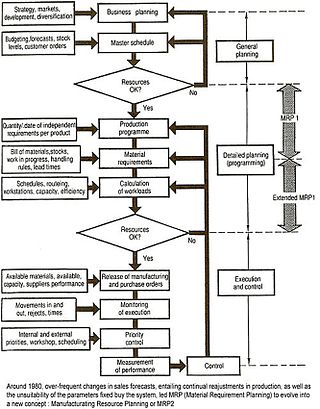
Enterprise resource planning (ERP) is the integrated management of main business processes, often in real time and mediated by software and technology. ERP is usually referred to as a category of business management software—typically a suite of integrated applications—that an organization can use to collect, store, manage and interpret data from many business activities. ERP systems can be local-based or cloud-based. Cloud-based applications have grown in recent years due to the increased efficiencies arising from information being readily available from any location with Internet access.
A management information system (MIS) is an information system used for decision-making, and for the coordination, control, analysis, and visualization of information in an organization. The study of the management information systems involves people, processes and technology in an organizational context. In other words it serves, as the functions of controlling, planning, decision making in the management level setting.

Accounts payable (AP) is money owed by a business to its suppliers shown as a liability on a company's balance sheet. It is distinct from notes payable liabilities, which are debts created by formal legal instrument documents. An accounts payable department's main responsibility is to process and review transactions between the company and its suppliers and to make sure that all outstanding invoices from their suppliers are approved, processed, and paid. The accounts payable process starts with collecting supply requirements from within the organization and seeking quotes from vendors for the items required. Once the deal is negotiated, purchase orders are prepared and sent. The goods delivered are inspected upon arrival and the invoice received is routed for approvals. Processing an invoice includes recording important data from the invoice and inputting it into the company's financial, or bookkeeping, system. After this is accomplished, the invoices must go through the company's respective business process in order to be paid.
Business software is any software or set of computer programs used by business users to perform various business functions. These business applications are used to increase productivity, measure productivity, and perform other business functions accurately.

An accounting information system (AIS) is a system of collecting, storing and processing financial and accounting data that are used by decision makers. An accounting information system is generally a computer-based method for tracking accounting activity in conjunction with information technology resources. The resulting financial reports can be used internally by management or externally by other interested parties including investors, creditors and tax authorities. Accounting information systems are designed to support all accounting functions and activities including auditing, financial accounting porting, -managerial/ management accounting and tax. The most widely adopted accounting information systems are auditing and financial reporting modules.

Manufacturingresource planning is a method for the effective planning of all resources of a manufacturing company. Ideally, it addresses operational planning in units, financial planning, and has a simulation capability to answer "what-if" questions and is an extension of closed-loop MRP.
E-procurement is the business-to-business or business-to-consumer or business-to-government purchase and sale of supplies, work, and services through the Internet as well as other information and networking systems, such as electronic data interchange and enterprise resource planning.
Strategic sourcing is the process of developing channels of supply at the lowest total cost, not just the lowest purchase price. It expands upon traditional organisational purchasing activities to embrace all activities within the procurement cycle, from specification to receipt, payment for goods and services to sourcing production lines where the labor market would increase firms' ROI. Strategic sourcing processes aim for continuous improvement and re-evaluation of the purchasing activities of an organisation.
Systems Applications Products audit is an audit of a computer system from SAP to check its security and data integrity. SAP is the acronym for Systems Applications Products. It is a system that provides users with a soft real-time business application. It contains a user interface and is considered very flexible. In an SAP audit the two main areas of concern are security and data integrity.
Enterprise software, also known as enterprise application software (EAS), is computer software used to satisfy the needs of an organization rather than its individual users. Enterprise software is an integral part of a computer-based information system, handling a number of business operations, for example to enhance business and management reporting tasks, or support production operations and back office functions. Enterprise systems must process information at a relatively high speed.
Oracle Applications comprise the applications software or business software of the Oracle Corporation both in the cloud and on-premises. The term refers to the non-database and non-middleware parts. The suite of applications includes enterprise resource planning, enterprise performance management, supply chain & manufacturing, human capital management, and advertising and customer experience.
Procurement software refers to a range of business software designed to streamline and automate purchasing processes for businesses and organizations. By managing information flows and transactions between procuring entities, suppliers, and partners, procurement software aims to cut costs, improve efficiency, and boost organizational performance.

SAP ERP is an enterprise resource planning software developed by the German company SAP SE. SAP ERP incorporates the key business functions of an organization. The latest version of SAP ERP (V.6.0) was made available in 2006. The most recent SAP enhancement package 8 for SAP ERP 6.0 was released in 2016. It is now considered legacy technology, having been superseded by SAP S/4HANA.

NetSuite Inc. is an American cloud-based enterprise software company that provides products and services tailored for small and medium-sized businesses (SMBs) including accounting and financial management, customer relationship management, inventory management, human capital management, payroll, procurement, project management and e-commerce software. NetSuite was founded in 1998 with headquarters in Austin, Texas. The company is widely seen as the first cloud computing software company, with its founding pre-dating that of Salesforce by about a month. Oracle Corporation acquired NetSuite for approximately US$9.3 billion in November 2016. The Oracle NetSuite Global Business Unit is managed by Executive Vice President Evan Goldberg as "Oracle’s Cloud ERP for Small and Mid-sized Enterprises with the ability to scale to Fortune 500 firms."
Invoice Processing : involves the handling of incoming invoices from arrival to payment. Invoices have many variations and types. In general, invoices are grouped into two types:
SAP Business ByDesign (ByD) is a cloud enterprise resource planning software that is sold and operated as software as a service by SAP SE. It is designed for small and medium-sized enterprises. The software is designed to provide business processes across application areas from financials to human resources with embedded business analytics, mobility, e-learning, and support.

Tryton is a three-tier high-level general purpose computer application platform on top of which is built an enterprise resource planning (ERP) business solution through a set of Tryton modules. The three-tier architecture consists of the Tryton client, the Tryton server and the database management system.
ERP Security is a wide range of measures aimed at protecting Enterprise resource planning (ERP) systems from illicit access ensuring accessibility and integrity of system data. ERP system is a computer software that serves to unify the information intended to manage the organization including Production, Supply Chain Management, Financial Management, Human Resource Management, Customer Relationship Management, Enterprise Performance Management.

Tungsten Network is a global electronic invoicing firm that provides supply chain financing services from international offices in the United Kingdom, United States, Bulgaria, Germany, and Malaysia. As a small- to medium-sized IT company, they have an estimated revenue of £31.3 million (GBP) as of July 2017. Tungsten Corporation Plc (TUNG) is reported to trade regularly on the London Stock Exchange. Main competitors in this arena include Tradeshift, Ariba, Basware, Taulia and iPayables.
Eclipse ERP is a real-time transaction processing accounting software used for order fulfillment, inventory control, accounting, purchasing, and sales. It was created for wholesale distributors in the Electrical, HVAC, Plumbing, and PVF industries, but is used by a wide range of market sectors. At one point this software was called Intuit Eclipse DMS, and Activant Eclipse, and Eclipse Distribution Management System.






